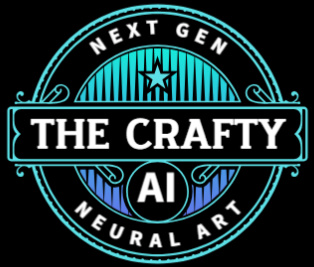www.thecraftyai.com
The Beginner's Guide to AI Prompting
Artificial Intelligence is no longer a futuristic dream—it’s a tool you can use today to write stories, generate art, automate tasks, and even start a business. But if you’re new to using AI, one of the first and most important things to understand is how to write effective AI prompts.
This short but to-the-point beginner’s guide to AI prompts will explain what prompts are, why they matter, how different AI tools interpret them, and how to write them effectively for different goals—whether you're generating images, writing content, or coding.
AI prompting starts with understanding that the words you use directly influence the images or responses the AI creates. Think of a prompt as your instruction manual—clear, descriptive language helps the AI better interpret your vision. Start simple by stating what you want (e.g., “a cat sitting on a windowsill at sunset”), then build by adding style, mood, or detail (like “in watercolor style” or “dreamy and soft lighting”). Experimentation is key, and you’ll learn by adjusting phrases and seeing how the AI responds. With practice, even complete beginners can master the art of prompting and unlock endless creative possibilities.
What Is an AI Prompt?
An AI prompt is the instruction or input you give to an artificial intelligence tool to produce a result. Think of it like a conversation with a very smart assistant that has no context until you give it direction.
For example:
In ChatGPT, a prompt could be: “Write a funny birthday message for a dog lover.”
In Midjourney, a prompt might look like: “A cyberpunk girl standing in the rain, neon background, cinematic lighting, ultra detail.”
In a coding AI like GitHub Copilot, it could be: “Create a JavaScript countdown timer.”
The AI responds based entirely on how you frame your request. That’s why learning to write good prompts is so important.
Why Are Prompts Important?
AI doesn’t "think" like a human. It doesn't know what you want unless you tell it clearly. Your prompt is your control panel—it determines the quality, relevance, tone, and usefulness of the AI’s response.
Poor prompts lead to:
Confusing or generic results
Repetition or irrelevant output
Frustration and wasted time
Well-crafted prompts lead to:
Creative and accurate responses
Time-saving automation
Enhanced productivity and creative output
The Different Types of AI Prompts
Depending on the software or tool you're using, your prompts may vary in style and purpose. Here are the most common categories:
1. Text Prompts
Used in tools like ChatGPT, Claude, Jasper, and Notion AI for writing tasks. These can include:
Blog articles
Social media captions
Emails
Poems and scripts
Translations and summaries
2. Image Prompts
Used in tools like Midjourney, DALL·E, and Stable Diffusion to create visual artwork. You describe the scene, style, lighting, angle, etc.
Example:
“A majestic lion wearing a golden crown, hyper-realistic, set in a desert landscape at sunset.”
There will also be a section where you can further improve or refine your results by entering words into the "negative" or "positive" prompt area.
3. Audio Prompts
Used in voice tools like ElevenLabs or podcast generators. You might prompt with:
“Read this paragraph in a calm, British female voice.”
“Narrate a bedtime story for a 5-year-old.”
4. Code Prompts
Used in AI coding assistants like GitHub Copilot or Replit AI. You can request:
Functional code snippets
Bug fixes
Explanations of complex code
Script generation
How to Write Better AI Prompts (With Examples)
Be Clear and Specific
Bad Prompt: “Tell me about dogs.”
Better Prompt: “Give me a list of the top 5 most popular dog breeds in the U.S. with their personality traits.”
Add Context
Let the AI know who, what, where, and why.
“Act like a travel agent and recommend a 3-day itinerary in Japan for first-time visitors who love nature and food.”
Set the Tone
If you want a playful tone, say so. If formal, mention it.
“Write a formal apology letter from a company to a client due to a delayed shipment.”
Use Format Instructions.
Tell the AI how you want the answer structured.
“Summarize this article into bullet points.”
“Give me a list of 10 ideas, each with a short description.”
Use Creative Anchors for Art Prompts
“A dreamy fairytale forest, soft lighting, fog, pastel color palette, high detail, by Studio Ghibli.”
Experiment with Roles.
Start prompts with “You are…” to guide how the AI should behave.
“You are a professional fitness coach. Create a beginner workout plan for someone who wants to lose weight at home.”
Common Prompting Mistakes Beginners Make
Being too vague – The AI guesses and often gets it wrong.
Overloading with details – Too many directions can confuse the output.
Ignoring formatting – Forgetting to tell the AI how you want the answer to look.
Not iterating – One bad response doesn’t mean failure. Refine and try again.
How to Improve Your Prompts Over Time
Prompting is a skill, not magic. You’ll get better by:
Practicing daily
Studying how others write prompts (Reddit, Discord, Twitter)
Saving your best results and tweaking them
Trying “prompt chaining”—breaking tasks into smaller prompts
Some communities even specialize in prompt engineering (the professional term for designing good prompts). You’ll find inspiration and shared prompt libraries all over the internet.
Why Prompts Are the Key to Mastering AI
Learning to write effective prompts is one of the most valuable digital skills of the future. Whether you’re a content creator, small business owner, designer, or student, understanding prompts gives you a creative superpower.
Remember: AI doesn’t replace you—it amplifies you. The better you can communicate with it, the more you can create, solve, automate, and grow.
© 2025. All rights reserved.

